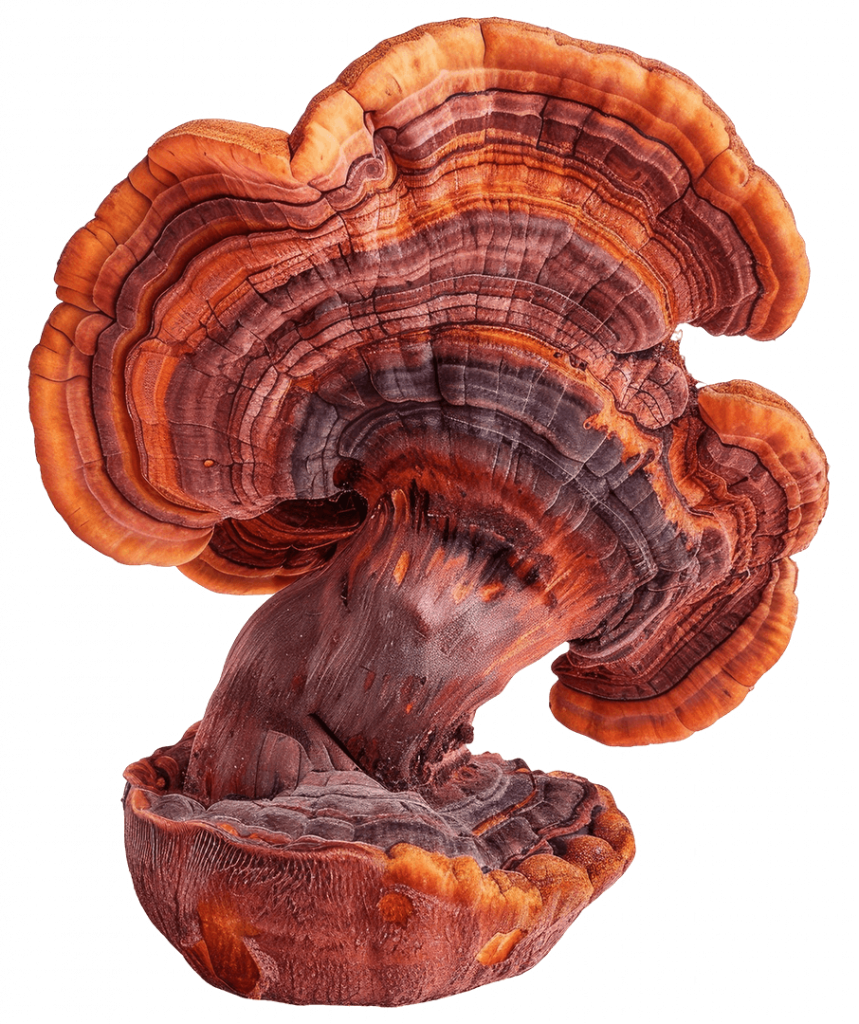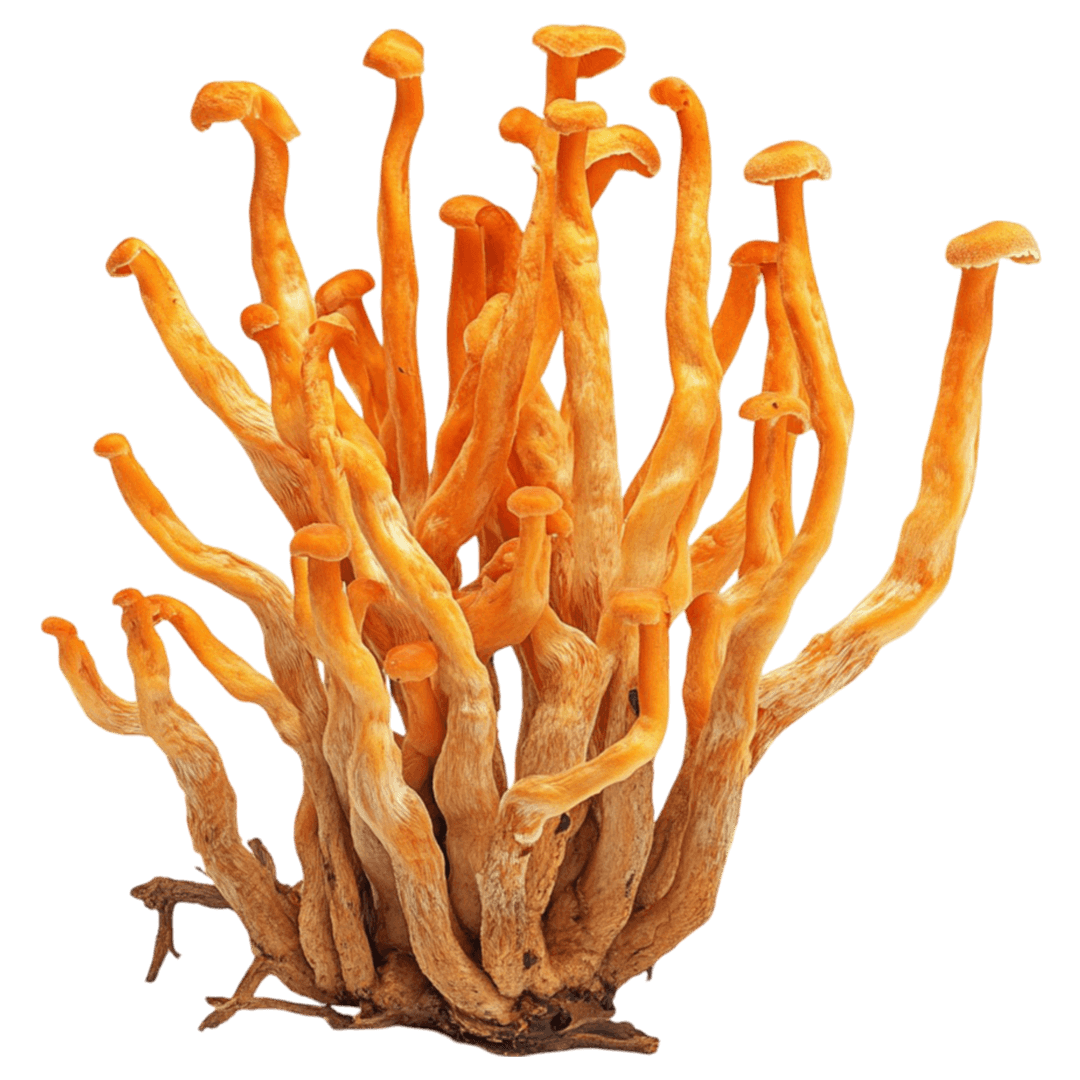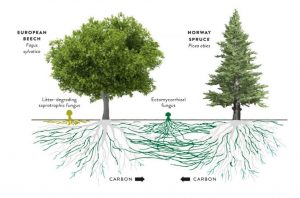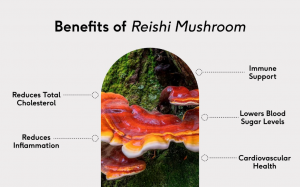Abstract
Fungi constitute one of the most functionally diverse and ecologically indispensable kingdoms of life. They are primary drivers of organic matter decomposition, major regulators of terrestrial carbon fluxes, and key partners in plant productivity through mycorrhizal symbioses.
Their enzymatic repertoire, particularly ligninolytic and cellulolytic systems, underpins their ability to recycle complex biopolymers such as lignin and cellulose that are otherwise resistant to degradation. Mycorrhizal fungi create extensive below-ground networks—so-called “mycorrhizal networks” or the “wood wide web”—that mediate interplant nutrient exchange, water acquisition, and resilience to biotic and abiotic stress.
Fungi also serve as ecosystem engineers by contributing to soil aggregation, hydrological regulation, and biogeochemical cycling of nitrogen, phosphorus, and trace minerals. Moreover, fungal secondary metabolites mediate ecological interactions, including competition, pathogenicity, and defense.
Mushroom-forming fungi (Basidiomycota) provide a macroscopic perspective of these ecological roles, with their reproductive structures serving as visible indicators of hidden mycelial biomass. Despite their critical roles, fungi are underrepresented in biodiversity assessments and are threatened by global environmental change.
This article provides a technical examination of the ecological significance of fungi, integrating molecular, physiological, and ecosystem-level perspectives.
Keywords: Mycorrhizae, decomposition, carbon cycle, ligninolytic enzymes, soil ecology, biodiversity, fungal ecology
1. Introduction
Fungi represent one of the most ancient and evolutionarily successful lineages within the Eukaryota, diverging from animals approximately one billion years ago (Berbee et al., 2020). Current estimates suggest that more than 6 million species exist globally, yet fewer than 150,000 have been formally described, indicating that the vast majority of fungal diversity remains unexplored (Hawksworth & Lücking, 2017).
Unlike autotrophic plants, fungi are obligate heterotrophs, lacking chlorophyll and depending on extracellular enzymatic digestion followed by absorptive nutrition. Their unique evolutionary innovations—such as filamentous hyphal growth, cell walls composed of chitin and glucans, and the secretion of a broad array of extracellular enzymes—have facilitated colonization of virtually every terrestrial and aquatic niche, from arctic tundra soils to hydrothermal vents in the deep sea.
The ecological importance of fungi is reflected in their ability to regulate critical ecosystem processes at multiple scales. At the molecular level, fungal enzymes enable the decomposition of structurally complex and recalcitrant biopolymers like cellulose and lignin, which are otherwise inaccessible to most organisms (Treseder & Lennon, 2015). At the community level, mycorrhizal partnerships represent some of the most ecologically successful interactions in evolutionary history. At the ecosystem level, fungi act as engineers of soil architecture, regulators of carbon and nutrient cycles, and modulators of biodiversity. Moreover, fungal necromass, representing dead hyphal material, is now recognized as one of the most stable contributors to long-term soil organic carbon storage, influencing climate regulation on a global scale (Kohler et al., 2015).
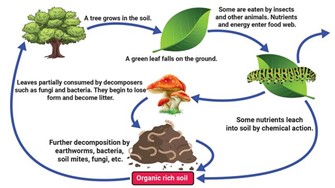
2. Fungi as Decomposers and Carbon Regulators
Fungi are the principal decomposers of terrestrial ecosystems due to their enzymatic capacity to hydrolyze and oxidize organic matter. Their enzymatic toolkit includes cellulases, hemicellulases, lignin peroxidases, manganese peroxidases, and laccases, which enable them to degrade plant cell wall polymers. White-rot fungi (Basidiomycota) are unique in their ability to completely mineralize lignin, a highly recalcitrant aromatic polymer, thereby playing a vital role in the global carbon cycle. Brown-rot fungi, in contrast, selectively degrade cellulose while modifying but not fully mineralizing lignin, influencing the structural and chemical properties of soil organic matter.
Globally, fungi mediate a significant portion of the carbon flux from plant biomass to the atmosphere as CO₂. Yet, fungal biomass also contributes to long-term soil carbon sequestration, making them critical regulators of the global carbon cycle (Treseder & Lennon, 2015).
3. Mycorrhizal Symbioses and the “Wood Wide Web”
Mycorrhizal associations, found in more than 80% of vascular plants, represent one of the most ecologically important plant-fungal symbioses. Arbuscular mycorrhizal fungi (AMF), belonging to the Glomeromycota, penetrate plant root cortical cells to form arbuscules, which serve as specialized structures for efficient phosphorus and micronutrient exchange. Ectomycorrhizal fungi (EMF), common among tree species in boreal and temperate forests, form an external mantle around roots and extend vast hyphal networks into the soil, allowing access to organic nitrogen pools and enhancing plant drought resistance (Simard et al., 2012).
These mycorrhizal networks redistribute nutrients and signaling molecules among plants, creating cooperative and competitive interactions. Such networks illustrate how fungi shape plant community dynamics.
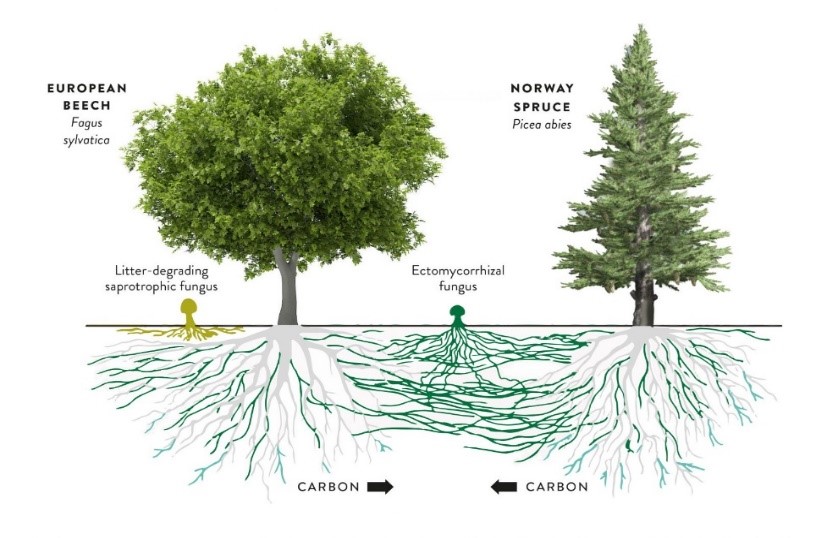
4. Soil Engineering and Biogeochemical Cycling
Fungal hyphae act as biological architects of soil ecosystems. By physically binding soil particles and producing extracellular polysaccharides and glycoproteins such as glomalin, fungi enhance soil aggregation, porosity, and water retention (Rillig, 2004).
In addition to their structural roles, fungi regulate essential nutrient cycles. Saprotrophic fungi mineralize organic nitrogen into bioavailable forms such as ammonium and nitrate, while mycorrhizal fungi facilitate phosphorus mobilization by producing phosphatases that release phosphate from organic complexes.
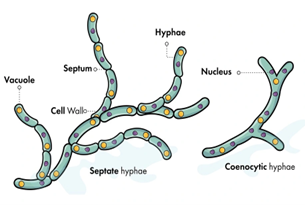
Additionally, fungi influence trace metal cycling by immobilizing toxic metals or mobilizing micronutrients like zinc and copper, highlighting their role in soil ecology and nutrient dynamics.
5. Fungi and Biodiversity Regulation
Fungi regulate biodiversity across trophic levels. As pathogens, they suppress dominant plant and insect populations. As endophytes, they protect plants by producing bioactive compounds. Secondary metabolites such as antibiotics and volatile organic compounds mediate microbial competition, influencing ecosystem biodiversity (Peay et al., 2016).
These multifaceted interactions reveal fungi as both stabilizers and disruptors within ecosystems, capable of enhancing plant productivity, suppressing competitors, and shaping overall biodiversity.
6. Mushrooms as Ecological Indicators
The fruiting bodies of fungi, particularly mushrooms of the Basidiomycota, are visible manifestations of vast and largely hidden mycelial networks. Beyond their reproductive function in spore dispersal, mushrooms serve as ecological indicators of ecosystem health.
The biochemical composition of mushrooms, rich in proteins, polysaccharides, and ergosterol, reflects the nutrient status of the underlying mycelium. Their abundance and diversity are often correlated with soil fertility, vegetation type, and levels of anthropogenic disturbance.
Thus, mushrooms provide an accessible lens through which fungal contributions to ecosystem functioning can be monitored.
7. Applied Ecological Roles of Fungi
Fungi are increasingly harnessed in applied ecology. White-rot fungi are widely studied for their ability to degrade xenobiotic pollutants, including polycyclic aromatic hydrocarbons (PAHs), synthetic dyes, and pesticides, through their ligninolytic enzyme systems.
In agriculture, inoculation with mycorrhizal fungi enhances crop yield and resilience, particularly under nutrient-poor or drought conditions. Furthermore, fungi contribute to climate change mitigation through long-term carbon sequestration, as fungal necromass forms one of the most stable fractions of soil organic carbon (Kohler et al., 2015).
8. Medicinal Mushrooms in Ecology
While fungi are widely celebrated for their ecological roles, certain medicinal mushrooms such as Reishi, Cordyceps, Shiitake, Chaga, and Lion’s Mane offer an integrated perspective on their dual ecological and therapeutic importance.
8.1 Reishi (Ganoderma lucidum)
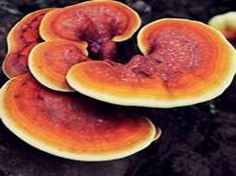
Ecologically, Reishi is a white-rot fungus specializing in lignin degradation, contributing to nutrient cycling and forest regeneration. Medicinally, it is known for immunomodulatory and antioxidant properties.
8.2 Cordyceps (Cordyceps militaris)
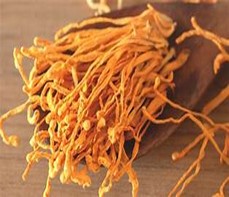
These fungi are parasitic on insects and arthropods, regulating insect populations and balancing ecosystems. Medicinally, they are valued for enhancing energy metabolism and immune responses.
8.3 Shiitake (Lentinula edodes)
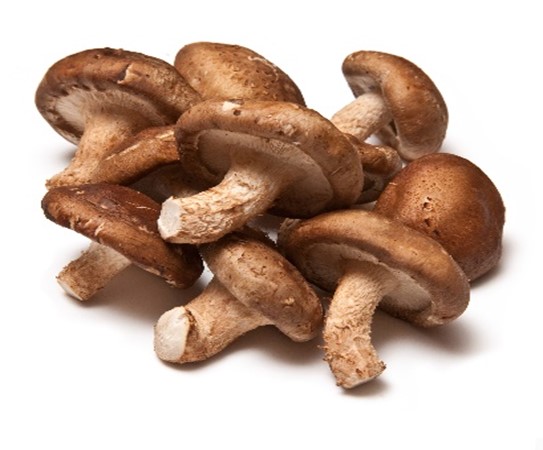
A saprotrophic fungus that decomposes hardwood logs, Shiitake accelerates carbon turnover in forest ecosystems. It is one of the most widely cultivated edible mushrooms and exhibits antimicrobial and cholesterol-lowering properties.
8.4 Chaga (Inonotus obliquus)
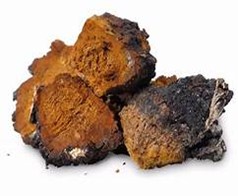
Ecologically, Chaga parasitizes birch trees, influencing forest health dynamics. Its medicinal potential lies in its antioxidant-rich compounds, particularly betulinic acid derivatives.
8.5 Lion’s Mane (Hericium erinaceus)

Found on decaying hardwood, Lion’s Mane contributes to lignocellulose decomposition and nutrient cycling. It is also renowned for promoting neural health by stimulating nerve growth factor synthesis.
These species illustrate how functional fungi integrate ecological importance with human applications.
Table 8.1: Medicinal Mushrooms and Their Ecological and Functional Roles
| Mushroom | Ecological Role | Functional Role |
|---|---|---|
| Reishi | White-rot decomposition of hardwood, nutrient cycling | Immunomodulation, antioxidant activity |
| Cordyceps | Insect population regulation | Energy enhancement, immune support |
| Shiitake | Hardwood decomposition, nutrient recycling | Antitumor, cholesterol regulation |
| Chaga | Parasitic on birch, forest succession influence | Antioxidant, anti-inflammatory |
| Lion’s Mane | Wood decomposition, habitat creation | Neuroregeneration, cognitive support |
9. Conclusion
Fungi are not merely decomposers but pivotal ecological engineers regulating carbon cycles, nutrient cycling, soil architecture, biodiversity, and plant productivity.
Their evolutionary innovations—hyphal growth, enzymatic degradation of recalcitrant polymers, and symbiotic versatility—have positioned them as indispensable components of terrestrial ecosystems.
As global environmental change intensifies, incorporating fungi into ecological and climate models becomes imperative for predicting ecosystem resilience and designing effective conservation strategies.
10. References
- Hawksworth, D. L., & Lücking, R. (2017). Fungal Diversity Revisited: 2.2 to 3.8 Million Species. Microbiology spectrum, 5(4). https://doi.org/10.1128/microbiolspec.FUNK-0052-2016
- Mueller, G., & Schmit, J. (2007). Fungal biodiversity: What do we know? What can we predict? Biodiversity and Conservation, 16, 1–5. https://doi.org/10.1007/s10531-006-9117-7
- Simard, S. W., et al. (2012). Mycorrhizal networks: Mechanisms, ecology and modelling. Fungal Biology Reviews, 26(1), 39–60.
- Treseder, K. K., & Lennon, J. T. (2015). Fungal traits that drive ecosystem dynamics on land. MMBR, 79(2), 243–262. https://doi.org/10.1128/MMBR.00001-15
- Kohler, A., et al. (2015). Convergent losses of decay mechanisms and rapid turnover of symbiosis genes in mycorrhizal mutualists. Nature Genetics, 47(4), 410–415. https://doi.org/10.1038/ng.3223
- Rillig, M. C. (2004). Arbuscular mycorrhizae, glomalin, and soil aggregation. Canadian Journal of Soil Science, 84(4), 355–363. https://doi.org/10.4141/S04-003
- Peay, K. G., Kennedy, P. G., & Talbot, J. M. (2016). Dimensions of biodiversity in the Earth mycobiome. Nature Reviews Microbiology, 14(7), 434–447. https://doi.org/10.1038/nrmicro.2016.59
